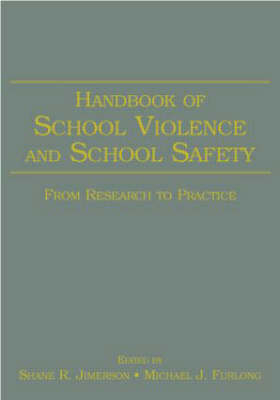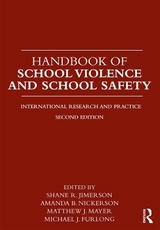
Handbook of School Violence and School Safety
Lawrence Erlbaum Associates Inc (Verlag)
978-0-8058-5224-0 (ISBN)
- Titel erscheint in neuer Auflage
- Artikel merken
Periodic, high-profile incidents of school violence both in the United States and around the world have understandably resulted in public demand for increased school safety. This demand has, in turn, led to school safety policies and practices that have raced ahead of empirical research. This situation is now changing. In both the United States and across the world a continuing flow of government-funded research studies now make it possible for schools and communities to implement school safety programs that are founded on sound scientific research.
This fourty one chapter Handbook is the first attempt to comprehensively profile (on a worldwide basis) the emerging field of school violence and safety research and practice. It covers the full range of school violence from harassment and bullying to serious physical assault. It also examines existing school safety programs and the research and theories that guide them. Examinations of current issues and projections of future research and practice are embedded within the discussions. In short, it helps map the boundaries of this rapidly growing, multidisciplinary field of study.
Key features of this important new book include:
Balance of Breadth and Depth–Coverage includes 41 chapters that provide an in-depth profile of the following aspects of school violence and school safety: 1. foundations 2. assessment and measurement 3. prevention and intervention, and 4. implementation.
Evidence-based Practice–Avoiding a one-size-fits-all approach to prevention and intervention, the focus throughout is on the application of evidence-based practice to those factors most commonly associated with school violence and safety.
Implications for Practice–A critical component of each chapter is a summary table delineating the implications for practice of the foregoing research.
The Handbook of School Violence and School Safety is an indispensable reference volume for scholars, college administration faculty and graduate students, in-service school administrators and safety officers, policymakers, and academic libraries serving these groups. It is also appropriate for graduate level courses wholly or partly devoted to the study of school violence and school safety.
Contents: Preface. Part I: Foundations of School Violence and Safety. S.R. Jimerson, G.M. Morrison, S.W. Pletcher, M.J. Furlong, Youth Engaged in Antisocial and Aggressive Behaviors: Who Are They? M.K. Demaray, C.K. Malecki, L.K. DeLong, Support in the Lives of Aggressive Students, Their Victims, and Their Peers. K.A. Bailey, Legal Knowledge Related to School Violence and School Safety. D. Osher, K. Dwyer, S.R. Jimerson, Safe, Supportive, and Effective Schools: Promoting School Success to Reduce School Violence. J. Larson, R.T. Busse, A Problem-Solving Approach to School Violence Prevention. A.B. Nickerson, K.M. Osborne, Crisis Preparedness, Response, and Management: Surveys of School Professionals. R.A. Astor, R. Benbenishty, R. Marachi, Making the Case for an International Perspective on School Violence: Implications for Theory, Research, Policy, and Assessment. Part II: Assessment and Measurement. J.D. Sharkey, M.J. Furlong, G. Yetter, An Overview of Measurement Issues in School Violence and School Safety Research. D.C. Smith, M.J. Furlong, P. Boman, Assessing Anger and Hostility in School Settings. M.R. Randazzo, R. Borum, B. Vossekuil, R. Fein, W. Modzeleski, W. Pollack, Threat Assessment in Schools: Empirical Support and Comparison With Other Approaches. R. Skiba, A.B. Simmons, R. Peterson, S. Forde, The SRS Safe Schools Survey: A Broader Perspective on School Violence Prevention. M.J. Mayer, The Current State of Methodological Knowledge and Emerging Practice in Evidence-Based Evaluation: Applications to School Violence Prevention Research. D.G. Cornell, P.L. Sheras, J.C.M. Cole, Assessment of Bullying. G.M. Morrison, M. Redding, E. Fisher, R. Peterson, Assessing School Discipline. R.A. Astor, R. Benbenishty, R. Marachi, H.A. Meyer, The Social Context of Schools: Monitoring and Mapping Student Victimization in Schools. M.J. Furlong, J.D. Sharkey, A Review of Methods to Assess Student Self-Report of Weapons on School Campuses. Part III: Research-Based Prevention and Intervention Programs. S.M. Swearer, J. Peugh, D.L. Espelage, A.B. Siebecker, W.L. Kingsbury, K.S. Bevins, A Socialecological Model for Bullying Prevention and Intervention in Early Adolescence: An Exploratory Examination. R.J. Hazler, J.V. Carney, Critical Characteristics of Effective Bullying Prevention Programs. S.P. Limber, The Olweus Bullying Prevention Program: An Overview of Its Implementation and Research Basis. M. Hirschstein, K.S. Frey, Promoting Behavior and Beliefs That Reduce Bullying: The Steps to Respect Program. K. Rigby, What We Can Learn From Evaluated Studies of School-Based Programs to Reduce Bullying in Schools. R.J. DioGuardi, L.A. Theodore, Understanding and Addressing Peer Victimization Among Students. E.L. Feindler, S. Weisner, Youth Anger Management Treatments for School Violence Prevention. D.C. Smith, J. Larson, D.R. Nuckles, A Critical Analysis of School-Based Anger Management Programs for Youth. P.D. Fitzgerald, L. Van Schoiack Edstrom, Second Step: A Violence Prevention Curriculum. M.T. Greenberg, C.A. Kusch‚, Building Social and Emotional Competence: The PATHS Curriculum. J.R. Sprague, R.H. Horner, Schoolwide Positive Behavioral Supports. J. Derzon, How Effective Are School-Based Violence Prevention Programs in Preventing and Reducing Violence and Other Antisocial Behaviors? A Meta-Analysis. S.E. Brock, S.R. Jimerson, S.R. Hart, Preventing, Preparing for, and Responding to School Violence With the National Incident Management System. Part IV: Implementing Comprehensive Safe School Plans. C. Griffiths, T. Weatherilt, Creating a Safe and Friendly School: Using a 360-Degree Approach. R. Benbenishty, R.A. Astor, R. Marachi, A National Study of School Violence in Israel: Implications for Theory, Practice, and Policy. R.S.L. Guzzo, F. Lacerda, Jr., A.E. Filho, School Violence in Brazil: A Psycholocial Perspective. J.A. Welsh, C.E. Domitrovich, The Safe Schools, Healthy Students Initiative in Rural Pennsylvania. K.H. Armstrong, O.T. Massey, M. Boroughs, Implementing Comprehensive Safe School Plans in Pinellas County Schools, Florida: Planning, Implementation, Operation, Sustainability, and Lessons Learned. G.G. Bear, S.P. Giancola, L.S. Goetz, J.P. Veach, Beyond Face Fidelity: When Less Is More. L.Z. Paige, S.N. Kitzis, J. Wolfe, J. Kitson, Implementing the Safe Schools/Healthy Students Initiative in Kansas. S. Telleen, Y.O.R. Kim, H. Stewart-Nava, R.C. Pesce, S. Maher, Implementing Comprehensive Safe School Plans: Effective School and Community Mental Health Collaborations to Reduce Youth Violence. D. Cornell, F. Williams, Student Threat Assessment as a Strategy to Reduce School Violence. R.B. Van Dyke, J.L. Schroeder, Implementation of the Dallas Threat of Violence Risk Assessment. L. Delizonna, I. Alan, H. Steiner, A Case Example of a School Shooting: Lessons Learned in the Wake of Tragedy. R. Skiba, S. Ritter, A. Simmons, R. Peterson, C. Miller, The Safe and Responsive Schools Project: A School Reform Model for Implementing Best Practices in Violence Prevention.
| Verlagsort | Mahwah |
|---|---|
| Sprache | englisch |
| Maße | 178 x 254 mm |
| Gewicht | 1293 g |
| Themenwelt | Sozialwissenschaften ► Pädagogik |
| Sozialwissenschaften ► Soziologie | |
| ISBN-10 | 0-8058-5224-7 / 0805852247 |
| ISBN-13 | 978-0-8058-5224-0 / 9780805852240 |
| Zustand | Neuware |
| Informationen gemäß Produktsicherheitsverordnung (GPSR) | |
| Haben Sie eine Frage zum Produkt? |
aus dem Bereich



